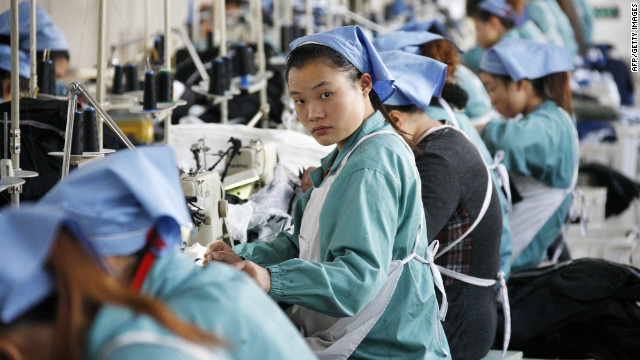|
A weaver works in a textile mill in Haian county, Jiangsu Province. Photo: CFP By Chen Yang Amid the economic downturn, China's textile industry is stepping up its pace to relocate from the eastern coastal areas to the central and western areas for their cheaper labor, better land and energy resources, as well as preferential policies from local governments. About 80 percent of the textile industry is distributed in the eastern areas, said Yang Jichao, secretary-general of China National Textile And Apparel Council (CNTAC). "Through the years the textile and garment companies' profitability dropped due to increasing property, energy and labor costs, so these areas become less attractive for investors." Fixed assets investment by the textile industry in five central provinces increased by 20.94 percent in the first seven months of this year, while the investment in the eastern provinces decreased by 6.34 percent during the same period, according to CNTAC. The westward movement dates back to 2000, Wang Qianjin, an analyst from Shanghai Setways Information Consulting Company, told the Global Times. "As a labor-intensive industry, low labor costs attracted companies to invest in central and western areas. Local governments also established preferential policies to attract the investment and boost the industry. " The State Council unveiled a three-year stimulus plan for the textile industry late April, saying the industry's output from the central and western areas will be raised to 20 percent by 2011. Central and western areas can take advantage of their cheap labor and natural resources and develop themselves into textile and garment manufacturing bases, while eastern and coastal areas can focus on research and development, branding and marketing, said the plan. The plan also encourages investment in the Xinjiang Uygur Autonomous Region to build it into a manufacturing base for cotton yarns, fabric and textiles. Meanwhile, guidelines on the domestic textile industrial relocation will be released soon, in an effort to avoid taking outdated technology to the new areas, according to an announcement released last August at a textile industry conference in Jiangxi Province. All eyes on Henan Province The China National Garment Association (CNGA) picked Henan Province in central China to be the pilot region for the textile industrial relocation this year. More than 2,000 companies attended a textile industrial relocation fair in Zhengzhou, capital of Henan Province, Thursday when 102 projects were signed and 18 million yuan ($2.64 million) worth of investment was attracted. The domestic investment came primarily from coastal areas including Zhejiang, Guangdong and Fujian provinces, accounting for 73.8 percent of the total investment, said Li Qingshu, head of Henan Provincial Bureau of Commerce. Henan Province's advantages include cheap operation cost and policy support, according to Li Wei, deputy director of the Henan Development and Reform Commission. The province's cotton output amounted to 650,000 ton in 2008, ranking fourth among China's cotton-growing provinces. Textile workers' salaries there were one third lower than their counterparts in eastern provinces, and the electricity prices are about 20 percent lower than in Shandong and Jiangsu provinces, according to figures from the National Bureau of Statistics. The local government has also listed the textile industry as the provincial pillar industry, and streamlined the investment procedures, said Li. "Our report on the garment industrial relocation says the domestic relocation carries less risk than relocating the textile factories overseas, due to increasing domestic demand and similar legal and cultural environments," Xie Qing, deputy secretary-general of CNGA, told the Global Times. Shanghai Setways' Wang said there are also problems in the domestic relocation movement, such as an incomplete industry chain and shortage of talents. "Transportation and training costs would raise companies' operation costs, so companies should make their decisions cautiously," he added. Representatives of Youngor Group, China's leading menswear manufacturer based in the eastern coastal city of Ningbo, Zhejiang Province and ranked 230th in the recently released China's Top 500 were at the Zhengzhou fair. "We are planning to extend our business in the central provinces, and we would have done it faster if it weren't for the economic crisis," Yu Jing, Youngor's public relations spokeswoman, told the Global Times. Yu said Youngor began looking west in 2004, when a manufacturing base was built in Chongqing in southwest China for 100 million yuan ($14.65 million). "Compared with Ningbo, the labor force and energy resources there are relatively cheaper," she added. Youngor signed an equity purchase agreement with a US firm Kellwood Company and its subsidiary Kellwood Asia in January 2008. Under the agreement, the company spent about $120 million buying the Smart Shirts business under Kellwood Asia, with 70 percent of the deal financed by banks, and earned a larger retail network overseas. "We invested another 100 million yuan ($14.65 million) to increase our productivity in Chongqing after the overseas purchase and now this base can produce 15,000 shirts every day. This figure is expected to increase to 24,000 by 2011. These products are mostly sold in the western provinces, so it saves us a lot in transportation costs," said Yu. Youngor also established a cotton textile companies in Xinjiang Uygur Autonomous Region in 2005. "We produce raw materials and an industry chain has been formed since then." Yu said these business has helped local governments relieve the employment pressure through creation of job opportunities. "There are more than 2,000 employees in Chongqing and over 1,000 employees in Xinjiang, most of whom were hired locally." |
|
Journey to the west
Updated: 2009-9-12 Source: Clobal Times

Recommended News
Photo Gallery
Most Popular




